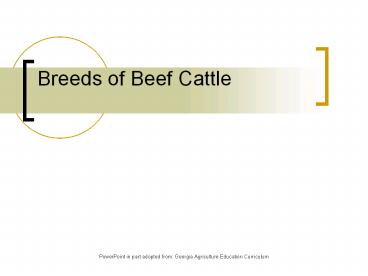Breeds of Beef Cattle - PowerPoint PPT Presentation
1 / 28
Title:
Breeds of Beef Cattle
Description:
Breeds of Beef Cattle ... Angus First imported from Scotland by George Grant of Kansas in 1837 Solid black in color Naturally polled Maternal High quality ... – PowerPoint PPT presentation
Number of Views:271
Avg rating:3.0/5.0
Title: Breeds of Beef Cattle
1
Breeds of Beef Cattle
2
(No Transcript)
3
Study Sheet
- Unit Introduction to Beef Production
- Lesson (2) Breeds of Beef Cattle
- Objective I will be able to identify the major
beef breeds and their significance to the beef
industry.
4
Study Questions
- How do the Bos indicus and Bos taurus species of
beef cattle differ? - What are the histories and identifying
characteristics of beef breeds common in
Missouri? - What are factors that influence breed selection?
5
Study Question 1
- How do the Bos indicus and Bos taurus species of
beef cattle differ?
6
Two species of Beef Cattle
- Bos indicus
- Bos taurus
7
Bos indicus Bos taurus
- Originated from Cattle in India
- Loose skin
- Large ears
- Humped
- Heat-resistant
- Insect-resistant
- Originated in Europe
- Tight hides
- Small ears
- No humps
- More tolerant of cold weather
8
How many breed of Beef Cattle exist?
- Worldwide there are over 200 breeds of beef
cattle. - We are going to learn about 16 breeds that are
common in Missouri.
9
Study Question 2
- What are the histories and identifying
characteristics of beef breeds common in
Missouri?
10
Angus
- First imported from Scotland by George Grant of
Kansas in 1837 - Solid black in color
- Naturally polled
- Maternal
- High quality carcasses with a large degree of
marbling
11
Red Angus
- Red color due to a recessive gene in black Angus
- Same characteristics as black Angus
12
Beefmaster
- Developed in Texas in 1931 by Tom Lasater
- ¼ Hereford, ¼ Shorthorn, ½ Brahman
- Red to almost white in color
- Horned or polled
- Good growth rate
- Hardy
- Maternal and fertile
13
Brahman
- Developed from Zebu cattle in India crossed with
several European Breeds - Gray to black in color
- Loose hides
- Large ears
- Humped
- Horned
- Heat-resistant
- Insect-resistant
14
Brangus
- Developed in the United States in the early
twentieth century - 5/8 Angus, 3/8 Brahman
- Black
- Polled Maternal
- High growth rate
- Thick carcasses with a minimum of excess fat
15
Charolais
- Introduced in the United States by the King Ranch
in the 1930s - Originally developed in France
- White
- Horned or polled
- Large
- Heavily muscled
- Fast-growing
16
Chianina
- Originated in Italy
- First used in the United States in the early
1970s - Used to produce show steers as a terminal breed
- Almost any color
- Horned or polled
- Fast Growing
- Extremely Large
17
Gelbvieh
- Originated in Germany
- Imported I the early 1970s
- Red to golden or black in color
- Horned or polled
- Gentle
- Very maternal
18
Hereford
- Imported from England by Henry Clay in 1817
- Red with white face and chest also white on
neck, feet and switch - Horned, but used to develop Polled Hereford breed
- Excellent foragers
- Tolerant of cold weather
19
Limousin
- Originated in France
- First introduced into the United States in the
late 1960s - Light red to dark red or black
- Horned or polled
- Lean
- Heavily muscled
20
Longhorn
- Originally from Spain
- Brought to Mexico and then Texas in the early
1500s - Extremely Hardy
- Almost any color or combination of colors
- Horned (spreading to four or more feet)
- Lean meat
- Adaptable to harsh environmental conditions
- Resistant to many diseases and parasites
21
Maine Anjou
- Originated in France
- Introduced to the United States around 1970
- Red and white, solid red, black, or black and
white in color - Horned or polled
- Heavily muscled
- Gentle
- Fast-growing
- Used extensively in producing show steers
22
Salers
- Originated in France
- Imported in the mid 1970s
- Black or dark cherry red in color
- Horned
- Easy calving
- High growth
23
Santa Gertrudis
- Developed on the King Ranch in Texas in the early
twentieth century - 5/8 Shorthorn, 3/8 Brahman
- Dark red
- Horned or polled
- Easy-calving
- Good foraging ability
24
Shorthorn
- Originated in England
- Red red white or roan in color
- Horned or polled
- Highly maternal
- Gentle
- High-quality carcasses
25
Simmental
- Originated in Switzerland
- First imported in 1969
- Solid red, red and white, yellow, black, or black
and white in color - Horned or polled
- Large
- Fast growing
- Maternal
- High milk production
26
Study Question 3
- What factors influence breed selection?
27
Breed Selection
- Needs of the producer
- Breeds used in the past
- Available feed and labor resources
- Goals of the operation
- Market trends
- Traits of the breeds
28
Review
- How do the Bos indicus and Bos taurus species of
beef cattle differ? - What are the histories and identifying
characteristics of beef breeds common in
Missouri? - What are factors that influence breed selection?


























![China Beef Cattle Farming Industry and Beef Market 2010-2019 [Market Research Report] PowerPoint PPT Presentation](https://s3.amazonaws.com/images.powershow.com/8317425.th0.jpg?_=201512120511)




